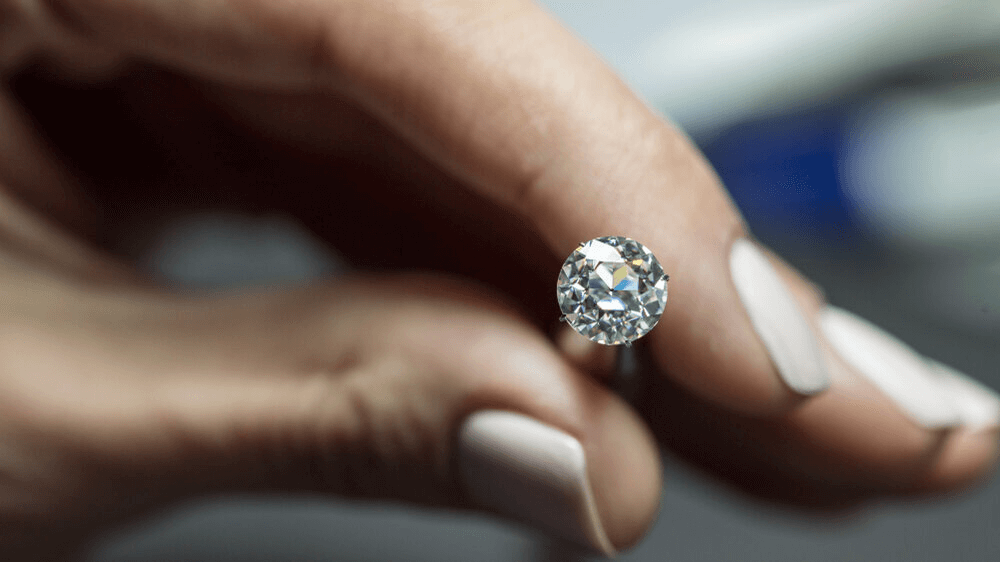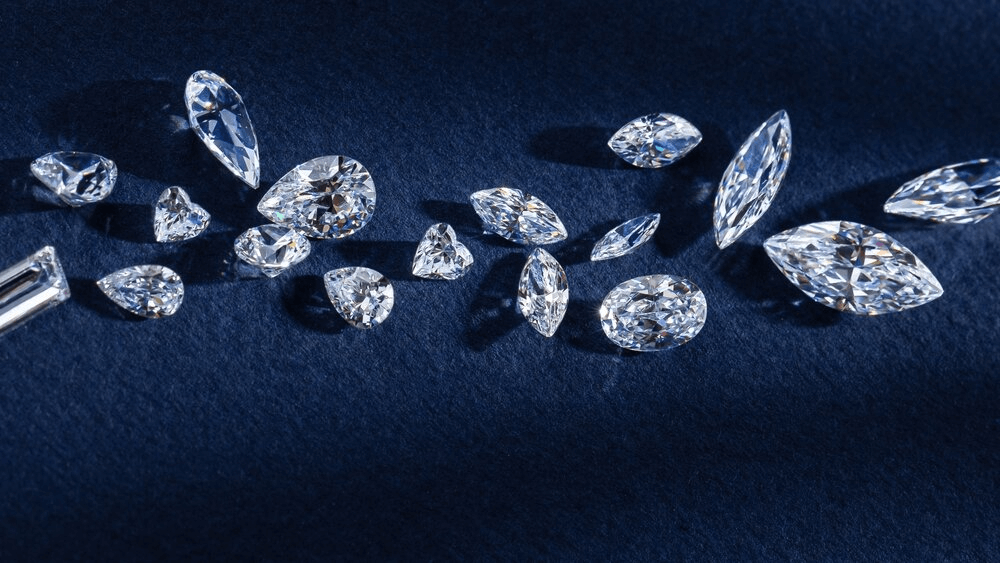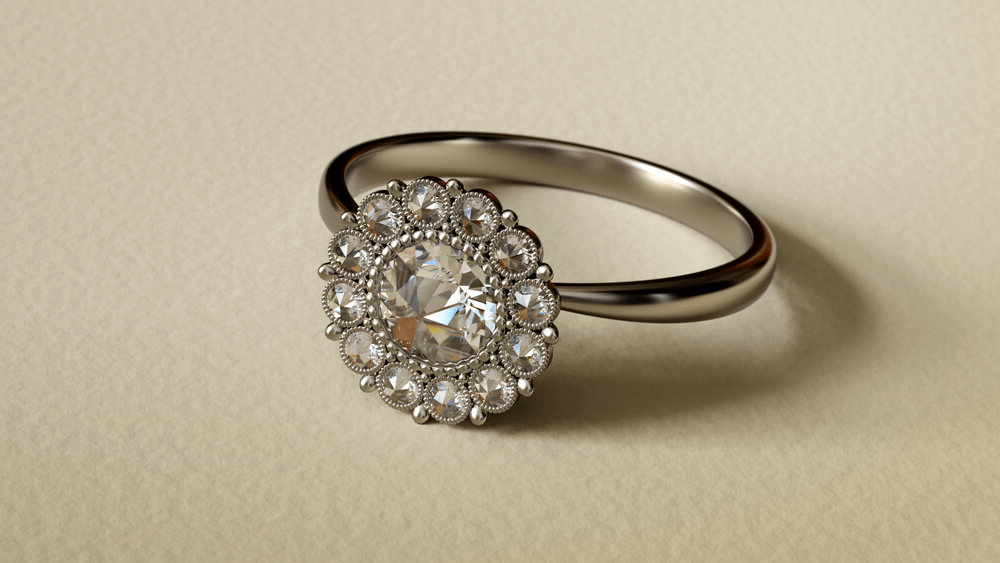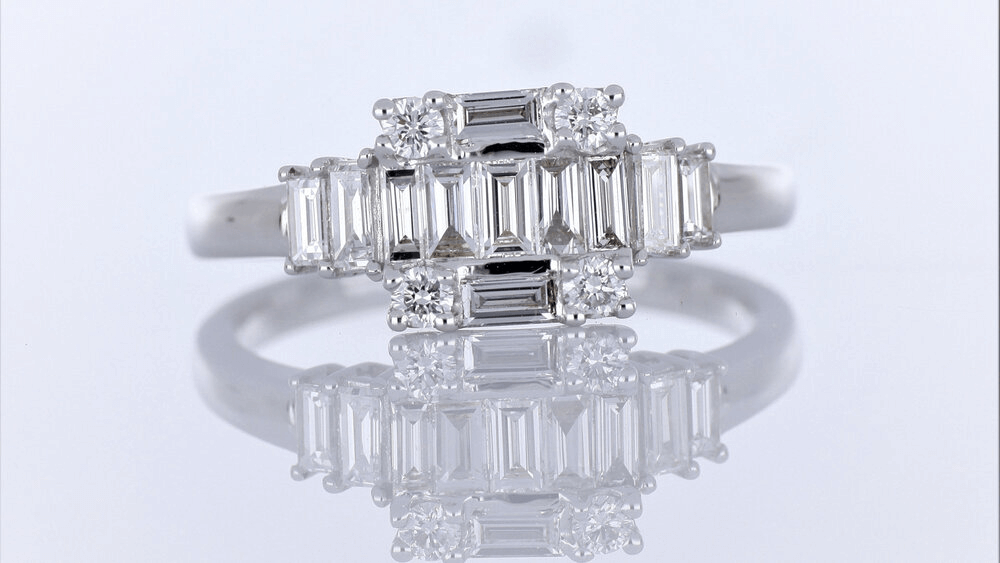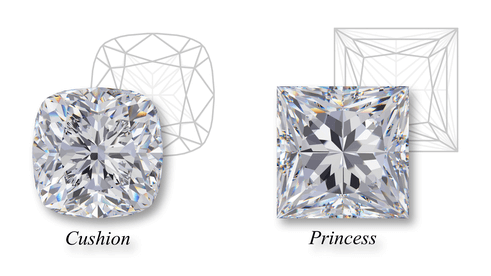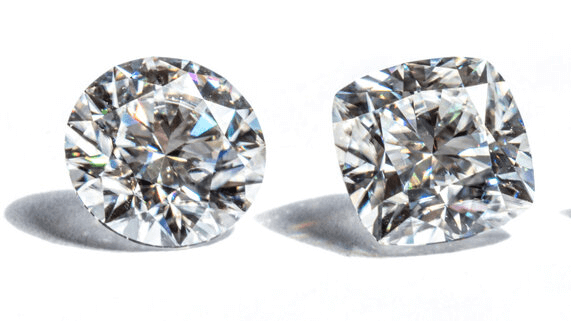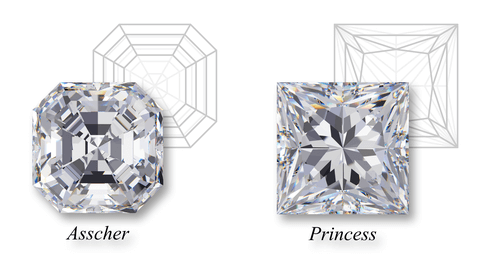Unlock the Perfect Princess Cut Diamond Now

By Gary A.

Edited by Olivia H.
Published Apr 29, 2021
Edited on Mar 31, 2025
Princess cut diamonds are the epitome of modern elegance, combining sharp geometric lines with unmatched brilliance. Explore our guide to discover the essential tips for choosing a stunning princess cut diamond engagement ring.

Navigate This Guide:
- 7 Quick Tips for Buying a Princess Cut Diamond Engagement Ring
- Introduction
- Defining the Princess Cut Diamond
- Historical Evolution: The Princess Cut’s Journey
- Key Considerations if You’re Thinking of a Princess Cut
- Princess Cut Size
- Durability Concerns for Princess Diamonds
- Princess Diamond Cost Considerations
- Choosing a Princess Cut Diamond
- Princess Cut Diamonds Pros and Cons
- Our Expert Take
- 7 FAQs
Before we dive deeper into the specifics, here are some practical tips to help guide your decision-making process:
7 Quick Tips for Buying a Princess Cut Diamond Engagement Ring
- Tip 1 – Understanding Cut Quality and Proportions Examine the Symmetry and Precision: For a princess cut diamond, symmetry is key. Ensure that the diamond’s square shape is perfectly aligned and the facets are precisely cut. This impacts the diamond’s ability to reflect light. Ideal Proportions Matter: Seek a length-to-width ratio close to 1.00 for a true square shape. Ratios between 1.00 and 1.05 can still appear square but may offer a slightly elongated look.
- Tip 2 – Checking for Durability and Protective Settings Inspect the Corners: Princess cut diamonds have sharp corners, making them more prone to chipping. Look for diamonds with slightly rounded corners or choose a setting that protects these points, such as a V-prong or bezel setting. Quality of the Setting: The ring setting should not only complement the stone but also provide adequate protection. A good setting will secure the diamond without obscuring its beauty.
- Tip 3 – Evaluating Brilliance and Fire Observe the Light Performance: Princess cut diamonds are known for their brilliance. Look at the diamond under different lighting conditions to see how it reflects light. A high-quality princess cut diamond should exhibit a good balance of white light (brilliance) and rainbow colors (fire).
- Tip 4 – Considering the Diamond’s Clarity Clarity is Crucial: While princess cut diamonds can hide some inclusions better than other cuts, it’s important to choose a diamond with a clarity grade that ensures no visible flaws. VS1 or VS2 clarity grades often offer a good balance of clarity and value.
- Tip 5 – Paying Attention to Color Grade Choose the Right Color Grade: Color grade affects the overall appearance of the diamond. For princess cuts, a grade of G to I offers a good balance between colorlessness and value, as slight color can be more difficult to detect in this cut.
- Tip 6 – Balancing Size and Quality Size vs. Quality Trade-off: Consider the size (carat weight) of the diamond in relation to its quality. A larger diamond with poor cut quality, clarity, or color may not be as visually appealing as a smaller diamond with better overall characteristics.
- Tip 7- Understanding the Girdle Thickness Check the Girdle: The girdle is the outer edge of the diamond where the crown meets the pavilion. For princess cut diamonds, a thin to slightly thick girdle is ideal. Avoid diamonds with extremely thin or thick girdles, as they can affect the diamond’s durability and appearance.
Now that you’ve got these practical tips, use Jeweler AI below to find the perfect engagement ring that suits your style and budget:
Introduction
It’s hard to imagine any diamond shape evoking images of luxury and affluence faster than the Princess cut. The sumptuousness of this cut is hinted at well before you even set eyes on those perfectly glassy facets or the precise and meticulous square shape that, so far, has gone unrivalled by any other popular diamond cut.
On name alone, it’s hard to imagine any other cut is better suited to a blushing bride.
Obviously, there’s a lot more to it than that – but the Princess cut certainly thrives on first impressions and, we’re willing to bed, closer inspection, too…
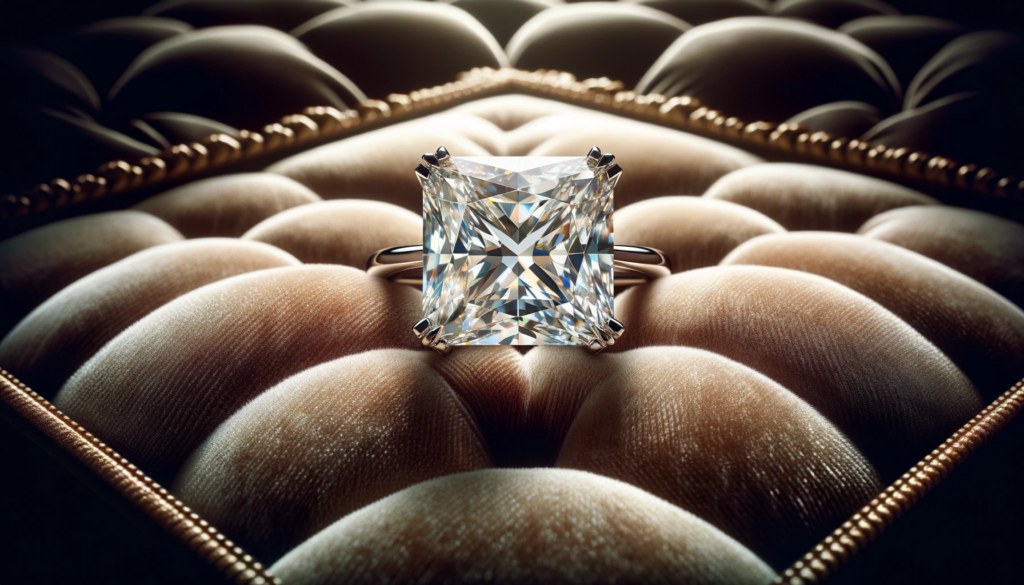
Defining the Princess Cut Diamond
The cut is a square diamond with sharp edges, and between 59 -78 facets which create a distinctive, chevron-like pattern within the diamond – visible when you look through the table.
What’s unique about the Princess cut is that if you look at it from above, it appears square. And when you look from the side, it looks more like an inverted pyramid.
The Princess cut features a large table, which allows a lot of light to enter and refract through the upper surface – ensuring a truly mesmerizing light performance. Its shape is unusual, given that most geometric diamond shapes feature beveled corners (creating an irregular octagon, rather than a true square) or rounded corners, as in the Cushion cut.
While it is possible to find Princess cuts featuring rectangular dimensions, rather than square, these are considered far less desirable on the market. Finding a Princess that is cut as close to the proportions of a square as possible is considered a far better use of your time and money.
The Princess cut is such a stunning and brilliant diamond, it’s no wonder that it’s such a popular choice for brides.
Historical Evolution: The Princess Cut’s Journey
While a similar cut was first developed in the 1960s, the design was then perfected and named the Princess cut in 1980 by Betazel Ambar and Israel Itzkowitz. From that moment on, the cut proved immensely popular – particularly throughout the 80s and 90s.
Most recently, Prince Harry proposed to Meghan, Duchess of Sussex, with a three stone engagement ring featuring the distinctive Princess cut back in 2017. Although she has since traded her original engagement ring in for a Cushion cut, the Princess sparked an explosion of popularity that continues on to this day.
The cut is modern, feminine, and beautiful – and, of course, totally befitting of modern-day royalty (hence the name) and any bride-to-be who has a taste for life’s greatest luxuries.
Why it’s Named the Princess Cut
The name was first given to a different cut in the 1960s – one that did not prove popular among shoppers – it was reused during the introduction of this cut, and, as you can imagine, was perfect for appealing to shoppers’ appreciation for the opulence and luxury of diamond.
While it may sound a lot less romantic, the Princess cut is also known by the name ‘square modified brilliant.’ This can be useful to know but, for the most part, any jeweler will refer to these diamonds as the Princess cut.
Key Considerations if You’re Thinking of a Princess Cut
It’s not difficult to understand the allure of the Princess cut. From the name to the distinctive internal structure, there’s a lot to love – but how does it look on the finger? Here’s what you need to know about Princess engagement rings.
The Uniqueness of the Princess Diamond
Yes – the Princess is commonly regarded as the second most popular diamond cut, alongside the Oval – and, of course, behind the Round Brilliant.
It’s highly unlikely that the Princess cut will ever surpass the Round Brilliant in terms of sheer popularity. This diamond cut has been the symbol for proposals and engagement rings for so many years that it seems pretty much impossible to imagine it ever slipping down the ranks.
Regardless, the popularity of the Princess has it sitting alongside the Oval as a highly compelling cut for couples around the world.
Analyzing the Princess Cut’s Popularity and Trend Influences
Yes, Princess diamonds have proven popular ever since their introduction in the early 1980s, but they are particularly popular at the moment.
The Princess is a great shape for so many reasons, and not least of all because it features a highly versatile and striking silhouette. The precise, geometric square shape is bold and modern in appearance, but subtly so. Its unique qualities are, for the most part, qualities that you only begin to truly pick up on when you look a little closer – and that’s what makes it the perfect cut for the term ‘modern classic’.
Just take a look at this Princess Solitaire in Yellow Gold, which takes the most traditional engagement ring design of all – the emblematic solitaire – and modernizes it using the angular shape of the Princess. The result is something truly stunning, without it straying too far from the traditional design.
But, that’s not to say that the Princess is incapable of creating something truly unique. This super feminine Princess Cut Infinity Engagement Ring manages to combine some of the most romantic design elements possible for something that will leave any new-fiancée starry-eyed: an elegant twisted shank, intricate pavé, blushing rose gold, and, of course, the Princess at its center.
Cuts like the Pear and Marquise are much more distinctive from a distance. There is, of course, absolutely nothing wrong with that – plenty of beautiful engagement rings are created using these bold shapes. But, if you’re on the hunt for something that isn’t tied to the ups and downs of trends, the Princess is a great cut to focus on.
In other words, yes it’s in style – and we’re willing to bet that it always will be.
Princess Cut Light Performance (Sparkle)
The Princess Cut is one of the best cuts out there for fire – and, of course, brilliance. This is one of the most coveted features of the Princess.
Its ability to turn like into mesmerizing flashes of white and colored light is down to its meticulously structured facets – so picking a very high quality cut here is essential (but more on that below).
Not only that, but the Princess offers the perfect opportunity to gain the most brilliance possible from the square shape. Unlike both the Radiant and the Cushion, it features those dramatic, sharply pointed corners and, unlike the Asscher, it features the brilliant facet pattern that ensures a truly stunning light performance from all angles.
A small amount of sparkle is lost due to the sharp corners of the shape. Whereas the Round Brilliant, Cushion and Oval feature smooth edges, the sharpness of the Princess prevents as much sparkle from being created in these parts of the stone. This isn’t major, and definitely isn’t a reason to write off the shape straightaway.
If you’re worried about the (albeit minor) loss of sparkle, then it would be worth looking into a halo ring setting further down the line. Take a look at this Princess Cut Halo Engagement Ring, which offers a tremendous sparkle thanks to the halo and pavé shank, which is sure to offset the slight loss of sparkle at the diamond’s corners.
What the Princess Cut Says About its Wearer
Princess cuts are feminine and luxurious, but also highly modern and refined. Their wearers tend to exude the same sense of style, and, while they appreciate the finer things in life, they remain highly sophisticated.
The Princess cut is more than just a fancy name. Its popularity stems from the substance beyond the name – the unique geometric pattern within the table, and that explosion of fire and brilliance we are treated to whenever the light falls upon the surface of the stone.
So, while its wearers may have been initially drawn in by the royal connotations of its name, you can be sure that there is a lot more going on beneath the surface. At heart, its wearers appreciate the innate beauty of a diamond – and the power of a skillful cut.
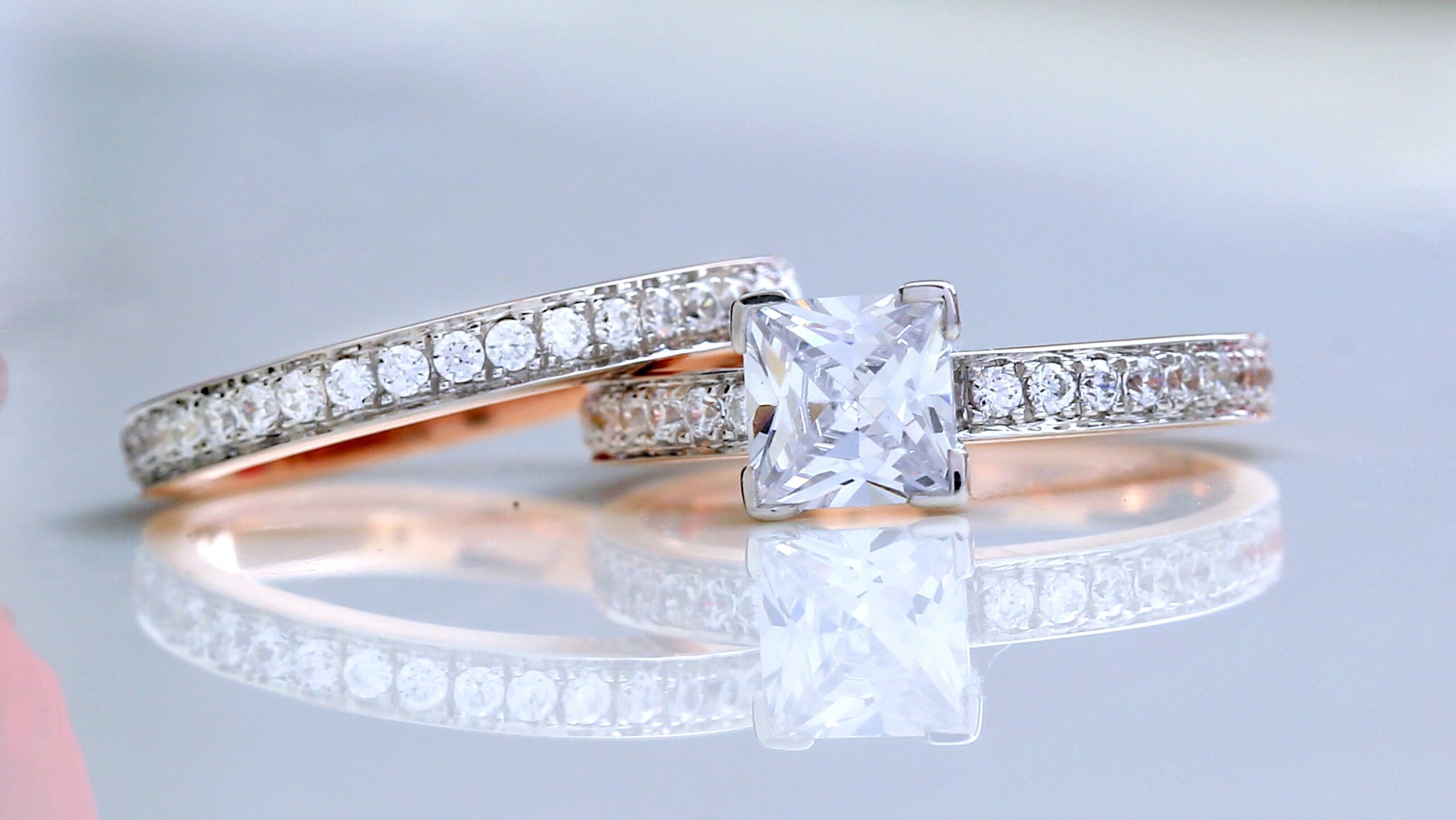
Princess Cut Size
Princess Cut Face-Up Appearance
The Princess Cut can appear larger than other diamonds – particularly the highly popular Round Brilliant – due to the fact that, with the right proportions, it will feature a larger table.
Obviously, how big, or small a Princess cut looks alongside other shapes will vary. A square Princess cut (far more desirable than a rectangle) won’t look as long as an Emerald, for instance, but it will look wider and more evenly proportioned – providing, of course, that the two diamonds feature the same carat weight.
In any case, a Princess will certainly command a lot of attention – no matter what diamond it’s held up against.
Size Expectations for 1 Carat Princess Diamonds
While this will depend on the proportions of the diamond, one that has been cut to a very high standard will measure approximately 5.5mm across.
Of course, ideally, the diamond will feature the same measurement on each side, in other to create that perfectly proportioned square – rather than a rectangle or, worse still, an irregular, wonky shape. We look at the ideal L/W ratio in more detail below.
A 2 carat Princess cut diamond will measure approximately 6.94mm – creating a very noticeable 1.44mm difference that will command even more attention on the finger – provided, once again, that it has been cut to ideal proportions.
As you might have already gathered, keeping a close eye on cut quality and proportion is essential to ensuring that you make a strong choice over your diamond. As with any shape, Cut is the most important of the Four Cs, and the one that has the most significant bearing on the sparkle and first-impression made by your diamond ring.
Durability Concerns for Princess Diamonds
Relatively speaking, Princesses are one of the more vulnerable diamond shapes – although they are still very strong, and weak points can be protected by a skilled jeweler.
While diamond is the hardest natural substance on earth, with a grade of 10 on the Mohs scale of hardness, any fine or sharpened points represent a definite weak point for a stone. This same fact holds true for the Pear, the Heart, and the Marquise.
The Princess, due to its shape, features four vulnerable corners – and this can be where the question of Princess vs Radiant leans more in the Radiant’s favor, due to its beveled corners.
Nevertheless, the popularity of the Princess cut is a testament to the fact that it is possible to protect this stone from damage. While some cutters now follow a process known as ‘chamfering,’ which adds a small (near microscopic) facet on each corner, it is possible for a skilled jeweler to protect the vulnerable points of the Princess cut with precise placement of the prongs.
Some settings, like the bezel, offer additional security, but they are not for everyone and may inhibit your diamond’s light performance.
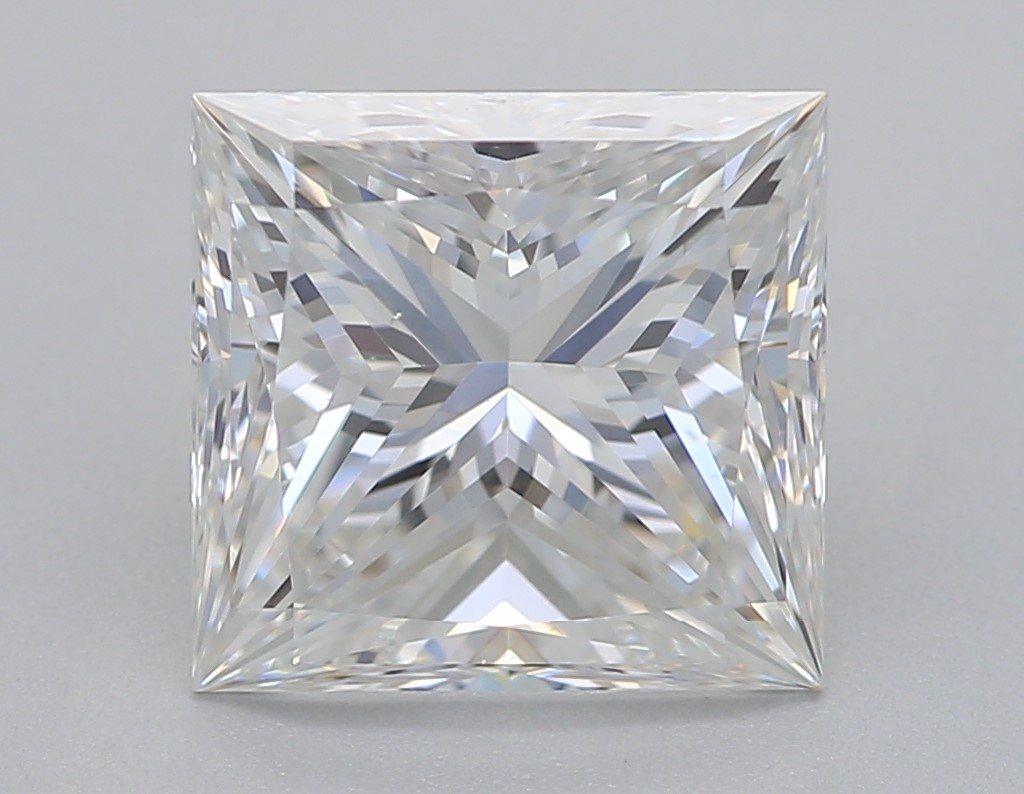
Princess Diamond Cost Considerations
While ‘talking money’ may go against the royal protocol, it’s important to know quite how much your dream Princess diamond engagement ring will set you back. Fortunately, there are no regal price points here, and plenty of ways to make your money go as far as possible.
Why the Princess Cut is More Expensive
It might surprise you to know that PRincess cuts actually aren’t more expensive. While popularity has increased the Princess cut’s value over the years, the truth is that Princess cuts are still one of the more affordable choices on the market.
This is mostly down to the fact that, for a diamond cutter, creating a Princess is a process that saves a lot more of the rough stone than creating many other shapes. While creating a Round Brilliant usually means sacrificing around 60% of the rough stone, a Princess can create as little as 10% wastage.
Since they don’t have to sacrifice anywhere near as much of the original weight of the diamond during the process, cutters don’t have to charge as much for the Princess.
Budgeting for a Diamond: The PRincess vs the Round
Per carat, a Princess is around 40% cheaper than the Round.
The Round remains the most important diamond cut (by far) because of two factors. First and foremost, its popularity (primarily driven by that high degree of sparkle, and the versatility of the shape) means that vendors are able to charge a little more.
Secondly, and perhaps more importantly, wastage is high. Just as we mentioned above, wasting around 60% of the original stone means that, for every 1 carat rough stone, cutters are able to create a Round Brilliant of around 0.40 carats.
Obviously, the exact numbers vary from stone to stone – and some will feature poor proportions for the sole reason that large diamonds always sell – but it’s useful to understand why Round diamonds remain so much more expensive than other shapes.
Average Cost of a 1 Carat Princess Diamond
While prices for poor quality stones – like those with visible inclusions or color – will be significantly lower, you can expect to find an eye clean and well-cut diamond from around $3,500 – $4,000 and up.
Remember that this just refers to the diamond, and not the ring setting – although the diamond will likely account for around 75% – 85% of your overall spend on your engagement ring.
Also, if you’re already doing equations in your head, don’t presume that budgeting for larger diamonds will be as simple as doubling the cost of a 1 carat diamond….
Average Cost of a 1 Carat Princess Diamond
A 2 carat Princess cut (again, with no visible inclusions or color, and a quality cut) will often cost upwards of $10,000, for the simple reason that larger diamonds are highly coveted by shoppers.
The premium cost of higher carat weights is something that any buyer will have to quickly get used to as they move ahead with their search.
As always, the best way to ensure you get the highest carat weight possible without sacrificing quality is to understand more about the process of choosing a diamond…
Choosing a Princess Cut Diamond
A Princess cut diamond should be set with prongs that protect the four corners in order to avoid chipping. Princess cuts work with many different styles, including solitaire and three-stone engagement rings.
For a classic Princess cut, we look for a length-to-width ratio of 1.00 – 1.029. and below. A length-to-width ratio of 1.05 – 1.08 may still look square because the sides of the diamond will create the illusion of a greater width in the center.
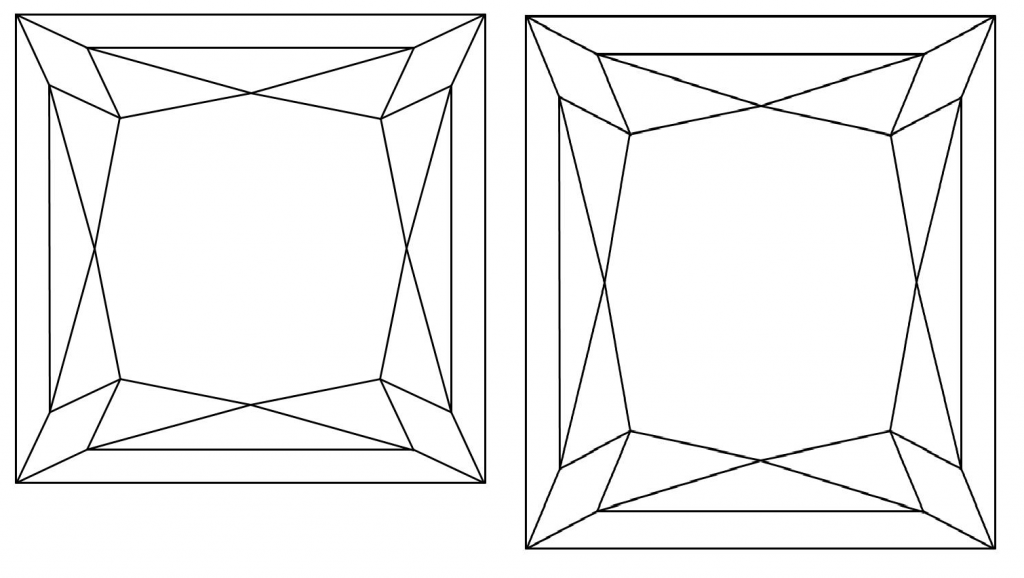
The following cut, color and clarity guides should be taken into consideration when choosing a Princess cut diamond:
Princess Cut Diamond Guide for the US – Cut
| Excellent | Very Good | Good | Fair | Poor | |
| Table % | 67 – 72.9 | 60 – 66.9 or 73 – 75.9 | 56 – 59.9 or 76 – 82.9 | 53 – 55.9 or 83 – 85.9 | <52.9 or >86 |
| Depth % | 67 – 72.9 | 64 – 66.9 or 73 – 74.9 | 58 – 63.9 or 75 – 79.9 | 56 – 57.9 or 80 – 84.9 | <55.9 or 85 |
| Girdle | Very Thin or Slightly Thick | Very Thin or Thick | Very Thin or Very Thick | Extremely Thin or Extremely Thick | |
| Culet | None | Very Small | Small | Medium | > Large |
| L/W Ratio | 1.00 – 1.029 | 1.03 – 1.039 | 1.04 – 1.059 | 1.06 – 1.08 | >1.09 |
Princess Cut Diamond Color Guide for the US
| Excellent | Very Good | Good | Fair | Poor | |
| Cut | Excellent | Very Good | Good | Fair – Poor | |
| Polish | Excellent | Very Good | Good | Fair – Poor | |
| Symmetry | Excellent | Very Good | Good | Fair – Poor | |
| Fluorescence | None | Faint | Medium | Strong – Very Strong |
Princess Cut Diamond Clarity Guide for the US
Most buyers prefer size over clarity and will buy a diamond of VS2 – SI1 Clarity.
| Excellent | Very Good | Good | Fair | Poor | |
| < 0.50 ct. | FL – VS2 | SI1 – SI2 | I1 | I2 | > I2 |
| 0.51 – 1.oo ct. | FL – VS1 | VS2 – SI1 | SI2 | I1 – I2 | > I2 |
| 1.00 – 2.00 ct. | FL – VVS2 | VS1 – VS2 | SI1 – SI2 | I1 | > I1 |
| > 2 ct. | FL – VVS2 | VS1- VS2 | SI1 – SI2 | I1 | > I1 |
Princess Cut Diamonds Pros and Cons
As always, there are advantages and disadvantages to any diamond cut, including the Princess.
Pros
A major plus side to choosing the Princess cut is the lower price-per-carat than other round cut diamonds, allowing you to get a bigger diamond for the same amount of money. It also gives the perfect opportunity for you to get the benefit of a brilliant facet pattern (meaning a lot of fire, brilliance and scintillation) within the square shape, creating something more modern and unique than the Round Brilliant.
Cons
One of the most significant downsides to choosing a Princess is, of course, the extra vulnerability to damage caused by its sharp edges. Because of the corners in the cut, some of the light and sparkle gets lost. Also, those sharp points need to be treated carefully within the ring design, as they are a lot more vulnerable to breaking than the smooth corners of, say, the Cushion.
Our Expert Take
The Princess is one of the most beautiful and dazzling diamond shapes out there, and it’s the perfect choice for many brides-to-be.
While the name may suggest an ultra-feminine, ultra-lavish cut, there’s so much more to the Princess than shoppers might imagine. It’s a bold, modern cut – one that masterfully combines some of the most coveted aspects of multiple older and more classic designs: the Round Brilliant and the highly geometric Emerald.
Its facet structure is close enough to some of the more traditional shapes that it doesn’t look too ‘out there,’ but remains intricate enough to live up to its royal name and offer something truly magnificent to place on the finger of your partner. If you want to know more, then take a look at our wide range of GIA graded Princess cut diamonds to set you off on the journey of finding the perfect ring for your partner.
7 FAQs
- Q: What makes a princess cut diamond unique?
- A: The princess cut diamond is known for its square shape with sharp, uncut corners and a brilliant facet pattern. This cut combines the elegance of a square shape with the brilliance similar to a round cut diamond.
- Q: How does a princess cut compare to a round cut in terms of sparkle?
- A: Princess cuts offer a similar level of brilliance to round cuts. The unique facet pattern of the princess cut enables excellent light reflection, producing a vibrant sparkle, though slightly less than the round cut.
- Q: Are princess cut diamonds more affordable than round cut diamonds?
- A: Generally, princess cut diamonds are more affordable than round cuts. This is due to the more efficient use of the rough diamond in the cutting process, resulting in less wasted material.
- Q: What is the best setting for a princess cut diamond?
- A: The best setting for a princess cut diamond typically includes V-prongs or a bezel setting to protect the sharp corners from chipping. Popular choices include solitaire, halo, and three-stone settings.
- Q: How should I prioritize the 4Cs for a princess cut diamond?
- A: For princess cuts, focus on cut and symmetry for maximum brilliance, followed by color and clarity. A well-cut princess diamond can hide some color and inclusions, balancing beauty and budget.
- Q: Can princess cut diamonds hide inclusions well?
- A: Yes, the intricate facet pattern of a princess cut can help hide some inclusions, especially compared to step-cut diamonds. However, choosing a diamond with no visible inclusions (VS2 or higher) is advisable for clarity.
- Q: Is a princess cut diamond suitable for daily wear?
- A: Yes, but it’s important to protect its sharp corners. Choosing a setting that guards these points ensures the diamond’s longevity and makes it suitable for everyday wear.
Unlock the beauty of princess cut diamonds with Jeweler AI – your pathway to the perfect ring.
FOLLOW-UP GUIDE SERIES

